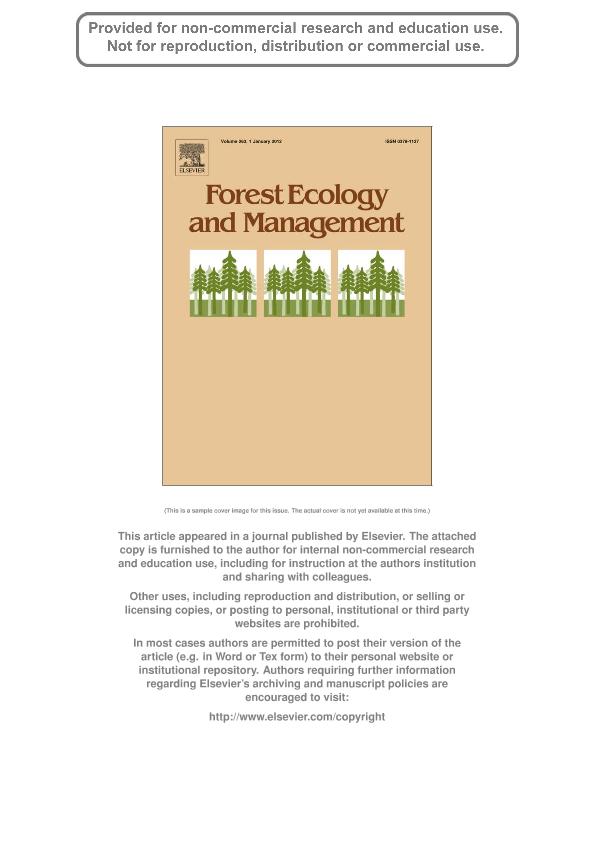Mostrar el registro sencillo del ítem
dc.contributor.author
Chaundy Smart, R. F. C.
dc.contributor.author
Smith, S. M.
dc.contributor.author
Malcolm, J. R.
dc.contributor.author
Bellocq, Maria Isabel

dc.date.available
2019-01-28T18:11:00Z
dc.date.issued
2012-04
dc.identifier.citation
Chaundy Smart, R. F. C.; Smith, S. M.; Malcolm, J. R.; Bellocq, Maria Isabel; Comparison of moth communities following clear-cutting and wildfire disturbance in the southern boreal forest; Elsevier Science; Forest Ecology and Management; 270; 4-2012; 273-281
dc.identifier.issn
0378-1127
dc.identifier.uri
http://hdl.handle.net/11336/68759
dc.description.abstract
Nocturnal macrolepidopteran fauna (moths) of the southern boreal forest of Ontario, Canada, were compared between forests clear-cut or burned by wildfire approximately 5. years previously to assess whether their assemblages differed following disturbance. Moths were light-trapped for 27. days during the summer in three burned and three clear-cut sites that had been formerly mature mixed jack pine (Pinus banksiana) forest. The dominant species varied throughout the summer (Protorthodes oviduca dominated in June, Orthodes cynica in July and Idia americalis in August), but they were similar between disturbance types. Diversity indices were similar although ordinations showed significant differences between the two disturbance types. Nine species were more significantly abundant in burn than clear-cut sites (Callopistra cordata, Cyclophora pendulinaria, Gluphisia septentrionis, Hyppa nr. xylinoides, Nemoria rubrifrontaria, Semiothisa neptaria, Spiramater lutra, and Tacparia detersata), whereas the converse was true for three species (Acronicta innotata, Phyllodesma Americana, and Euxoa comosa). Vegetation composition, disturbance age, percentage of jack pine pre-disturbance, and amount of downed woody debris and snags were the most important environmental correlates of moth community composition. Our study supports that of previous work on the effects of forest disturbance and biodiversity suggesting that clear-cutting may emulate wildfire for some organisms, but not for others. Thus, forest managers must consider multiple aspects of forest structure in attempting to use clear-cuts to mimic fire.
dc.format
application/pdf
dc.language.iso
eng
dc.publisher
Elsevier Science

dc.rights
info:eu-repo/semantics/openAccess
dc.rights.uri
https://creativecommons.org/licenses/by-nc-sa/2.5/ar/
dc.subject
Boreal Forest
dc.subject
Clear-Cutting
dc.subject
Disturbance
dc.subject
Jack Pine
dc.subject
Moths
dc.subject
Wildfire
dc.subject.classification
Otras Ciencias Biológicas

dc.subject.classification
Ciencias Biológicas

dc.subject.classification
CIENCIAS NATURALES Y EXACTAS

dc.title
Comparison of moth communities following clear-cutting and wildfire disturbance in the southern boreal forest
dc.type
info:eu-repo/semantics/article
dc.type
info:ar-repo/semantics/artículo
dc.type
info:eu-repo/semantics/publishedVersion
dc.date.updated
2019-01-25T13:34:30Z
dc.journal.volume
270
dc.journal.pagination
273-281
dc.journal.pais
Países Bajos

dc.journal.ciudad
Amsterdam
dc.description.fil
Fil: Chaundy Smart, R. F. C.. University of Toronto; Canadá
dc.description.fil
Fil: Smith, S. M.. University of Toronto; Canadá
dc.description.fil
Fil: Malcolm, J. R.. University of Toronto; Canadá
dc.description.fil
Fil: Bellocq, Maria Isabel. Consejo Nacional de Investigaciones Científicas y Técnicas. Oficina de Coordinación Administrativa Ciudad Universitaria. Instituto de Ecología, Genética y Evolución de Buenos Aires. Universidad de Buenos Aires. Facultad de Ciencias Exactas y Naturales. Instituto de Ecología, Genética y Evolución de Buenos Aires; Argentina
dc.journal.title
Forest Ecology and Management

dc.relation.alternativeid
info:eu-repo/semantics/altIdentifier/url/https://www.sciencedirect.com/science/article/pii/S0378112711005135
dc.relation.alternativeid
info:eu-repo/semantics/altIdentifier/doi/https://doi.org/10.1016/j.foreco.2011.08.021
Archivos asociados
